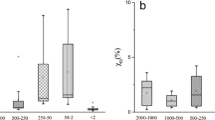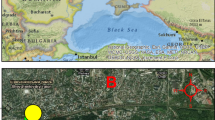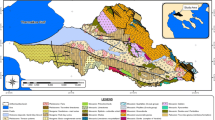Abstract
This study is close to an earlier urban soil survey carried out for a rapidly growing city with a high traffic density in Aurangabad city, India. Consequently, it aims to use the environmental magnetism approach to assess roadside emissions at a known polluted site. Magnetic measurements have been successfully implemented in soil studies and seem to be a suitable approach for pollution assessment in industrial and roadside areas of the study area. The present study was accomplished for magnetic susceptibility, isothermal remanent magnetization, coercivity, hysteresis measurements, thermomagnetic curves, scanning electron microscopy, and energy-dispersive spectroscopy analysis to evaluate the absolute fraction of magnetic minerals in bulk soil samples. The soils displayed variation in magnetic susceptibility values, which was influenced by concentration, domain states, and morphological characteristics of magnetic minerals. Substantial variation in the mineralogical composition of soils deriving from different industrial activities was noticed. The results indicate that industrial and roadside soil samples with mostly coarser and irregular-shaped show ferrimagnetic minerals. The presence of iron–titanium combination in most of the samples is due to titanomagnetite accompanying the titanium-bearing grains. In soils, a higher amount of ferrimagnetic minerals (magnetite, titanomagnetite, maghemite) with a minor content of antiferromagnetic minerals (hematite/goethite) was noticed. These studies reveal that magnetic and morphological characterization of soils can be used as an appropriate tracer for industrial and roadside soil pollution, which leads to new avenues for more detailed chemical mapping.








Similar content being viewed by others
Data Availability
The data used to support the findings of this study are included within the article.
References
Banerjee, S. K., King, J., & Marvin, J. (1981). A rapid method for magnetic granulometry with applications to environmental studies. Geophysical Research Letters, 8, 333–336. https://doi.org/10.1029/GL008i004p00333
Banerjee, S., Kumar, A., Rana, V., Maity, S., & Srivastava, H. (2021). Magnetic susceptibility mapping of roadside pollution in the Banaras Hindu University campus. Varanasi. India current science, 121(8), 1046–1055. https://doi.org/10.18520/cs/v121/i8/1046-1055
Basavaiah, N. (2011). Geomagnetism: Solid earth and upper atmosphere perspectives. Springer.
Basavaiah, N., Blaha, U., Das, P. K., Deenadayalan, K., Sadashiv, M. B., & Schulz, H. (2012). Evaluation of environmental magnetic pollution screening in soils of basaltic origin: Results from Nashik Thermal Power Station, Maharashtra, India. Environmental Science and Pollution Research, 19, 3028–3038. https://doi.org/10.1007/s11356-012-0816-1
Beckwith, P. R., Ellis, J. B., Revitt, D. M., & Oldfield, F. (1986). Heavy metal and magnetic relationships for urban source sediments. Physics of the Earth and Planetary Interiors, 42, 67–75. https://doi.org/10.1016/S0031-9201(86)80009-7
Bijaksana, S., & Huliselan, E. K. (2010). Magnetic properties and heavy metal content of sanitary leachate sludge in two landfill sites near Bandung. Indonesia. Environmental Earth Science, 60(2), 409–419. https://doi.org/10.1007/s12665-009-0184-4
Bourliva, A., Papadopoulou, L., & Aidona, E. (2016). Study of road dust magnetic phases as the main carrier of potentially harmful trace elements. Science of the Total Environment, 553, 380–391. https://doi.org/10.1016/j.scitotenv.2016.02.149
Boyko, T., Scholger, R., & Stanjek, H. (2004). Topsoil magnetic susceptibility mapping as a tool for pollution monitoring: Repeatability of in situ measurements. Journal Applied Geophysics, 55, 249–259. https://doi.org/10.1016/j.jappgeo.2004.01.002
Bucko, M. S., Magiera, T., Johanson, B., Petrovsky, E., & Pesonen, L. J. (2011). Identification of magnetic particulates in road dust accumulated on roadside snow using magnetic, geochemical and micro-morphological analyses. Environmental Pollution, 159, 1266–1276. https://doi.org/10.1016/j.envpol.2011.01.030
Bucko, M. S., Magiera, T., Pesoen, L. J., & Janus, B. (2010). Magnetic, geochemical, and microstructural characteristics of road dust on roadsides with different traffic volumes-Case study from Finland. Water Air Soil Pollution, 209, 295–306. https://doi.org/10.1007/s11270-009-0198-2
Chaparro, M. A. E., Bidegain, J. C., Sinito, A. M., Jurado, S. S., & Gogorza, C. S. G. (2004). Relevant magnetic parameters and heavy metals from relatively polluted stream sediments- Vertical and longitudinal distribution along a cross-city stream in Buenos Aires Province. Argentina. Studia Geophysica Et Geodaetica, 48(3), 615–636. https://doi.org/10.1023/B:SGEG.0000037474.08544.8e
Chaparro, M. A. E., Gogorza, C. S. G., Irurzun, M. A., & Sinito, A. M. (2006). Review of magnetism and heavy metal pollution studies of various environments in Argentina. Earth, Planets and Space, 58, 1411–1422. https://doi.org/10.1186/BF03352637
Chaparro, M. A. E., Chaparro, M. A. E., Marinelli, C., & Sinito, A. M. (2008). Multivariate techniques as alternative statistical tools applied to magnetic proxies for pollution: A case study from Argentina and Antarctica. Environmental Geology, 54, 365–371. https://doi.org/10.1007/s00254-007-0823-6
Crosby, C.J. (2012). Application of mineral magnetic measurements as a pollution proxy for urban road deposited sediment. Ph. D. thesis, University of Wolverhampton. http://hdl.handle.net/2436/265493
Crosby, C. J., Fullen, M. A., Booth, C. A., & Searle, D. E. (2014). A dynamic approach to urban road deposited sediment pollution monitoring (Marylebone Road, London, UK). Journal Applied Geophysics, 105, 10–20. https://doi.org/10.1016/j.jappgeo.2014.03.006
Day, R., Fuller, M., & Schmidt, V. A. (1977). Hysteresis properties of titanomagnetites: Grain-size and compositional dependence. Physics of the Earth & Planetary Interior, 13(4), 260–267. https://doi.org/10.1016/0031-9201(77)90108-X
Dearing, J. A., Dann, R. J. L., Hay, K., Lees, J. A., Loveland, P. J., Maher, B. A., & O’Grady, K. (1996). Frequency- dependent susceptibility measurements of environmental materials. Geophysical Journal IntErnational, 124(1), 228–240. https://doi.org/10.1111/j.1365-246X.1996.tb06366
Deshpande, G. G. (2012). Geology of Maharashtra, published by the Geological Society of India, Bangalore, 156–157.
Evans, M.E., & Heller, F. (2003). Environmental magnetism: Principles and applications of enviromagnetics. Journal of Quaternary Science, Academic press, (pp.311) San Diego. https://doi.org/10.1002/jqs.858
Gargiulo, J. D., Kumar, R. S., Chaparro, M. A. E., Chaparro, M. A. E., Natal, M., & Rajkumar, P. (2016). Magnetic properties of air suspended particles in thirty-eight cities from south India. Atmospheric Pollution Research, 7(4), 626–637. https://doi.org/10.1016/j.apr.2016.02.008
Gautam, P., Blaha, U., & Appel, E. (2005). Magnetic susceptibility of dust loaded leaves as a proxy of traffic related heavy metal pollution in Kathmandu city. Nepal. Atmospheric Environment, 39(12), 2201–2211. https://doi.org/10.1016/j.atmosenv.2005.01.006
Georgeaud, V. M., Rochette, P., Ambrosi, J. P., Vandamme, D., & Williamson, D. (1997). Relationship between heavy metals and magnetic properties in a large polluted catchment: The Etang de Berre (South of France). Physics and Chemistry of the Earth, 22, 211–214. https://doi.org/10.1016/S0079-1946(97)00105-5
Goddu, S. R., Appel, E., Jordanova, D., & Wehland, R. (2004). Magnetic properties of road dust from Visakhapatnam (India) - Relationship to industrial pollution and road traffic. Physics & Chemistry of the Earth, 29(13–14), 985–995. https://doi.org/10.1016/j.pce.2004.02.002
Gudadhe, S. S., Sangode, S. J., Patil, S. K., Chate, D. M., Meshram, D. C., & Badekar, A. G. (2012). Pre- and post-monsoon variations in the magnetic susceptibilities of soils of Mumbai metropolitan region: Implications to surface redistribution of urban soils loaded with anthropogenic particulates. Environmental Earth Science, 67, 813–831. https://doi.org/10.1007/s12665-012-1528-z
Hay, K. L., Dearing, J. A., Baban, S. M. J., & Loveland, P. (1997). A preliminary attempt to identify atmospherically-derived pollution particles in English topsoils from magnetic susceptibility measurements Physics and Chemistry of The. Earth, 22(1), 207–210. https://doi.org/10.1016/S0079-1946(97)00104-3
Hofmann, V., Knab, M., & Appel, E. (1999). Magnetic susceptibility mapping of roadside pollution. Journal of Geochemical Exploration, 66(1–2), 313–326. https://doi.org/10.1016/S0375-6742(99)00014-X
Jordanova, N. V., Jordanova, D. V., Veneva, L., Yorova, K., & Petrovsky, E. (2003). Magnetic response of soils and vegetation to heavy metal pollution - A case study. Environmental Science & Technology, 37(19), 4417–4424. https://doi.org/10.1021/es0200645
Kapicka, A., Petrovsky, E., Ustjak, S., & Machackova, K. (1999). Proxy mapping of fly-ash pollution of soils around a coal burning power plant: A case study in the Czech Republic. Journal of Geochemical Exploration, 66(1–2), 291–297.
Karimi, R., Ayoubi, S., Jalalian, A., Hosseini, A. R. S., & Afyuni, M. (2011). Relationships between magnetic susceptibility and heavy metals in urban topsoil in the arid region of Isfahan, central Iran. Journal of Applied Geophysics, 74(1), 1–7. https://doi.org/10.1016/j.jappgeo.2011.02.009
Kim, W., Doh, S. J., Park, Y. H., & Yun, S. T. (2007). Two - year magnetic monitoring in conjunction with geochemical and electron microscopic data of roadside dust in Seoul. Korea. Atmospheric Environment, 41(35), 7627–7641. https://doi.org/10.1016/j.atmosenv.2007.05.050
Lee, S., Kim, S., & Kim, H. (2020). Tracing of traffic-related pollution using magnetic properties of topsoil in Daejeon. Korea. Environmental Earth Science, 79, 485. https://doi.org/10.1007/s12665-020-09223-9
Liu, Q. S., Roberts, A. P., Torrent, J., Horng, C. S., & Larrasoana, J. C. (2007). What do the HIRM and S-ratio really measure in environmental magnetism? Geochemistry, Geophysics, Geosystems, 8(9), Q09011. https://doi.org/10.1029/2007GC001717
Liu, Q., Roberts, A. P., Larrasoana, J. C., Banerjee, S. K., Guyodo, Y., Tauxe, L., & Oldfield, F. (2012). Environmental magnetism: Principles and applications. Reviews of Geophysics, 50, RG4002. https://doi.org/10.1029/2012RG000393
Liu, D., Ma, J., Sun, Y., & Li, Y. (2016). Spatial distribution of soil magnetic susceptibility and correlation with heavy metal pollution in Kaifeng City, China. CATENA, 139, 53–60. https://doi.org/10.1016/j.catena.2015.11.004
Lourenco, A. M., Rocha, F., & Gomes, C. R. (2012). Relationships between magnetic parameters, chemical composition and clay minerals of topsoil near Coimbra, central Portugal. Natural Hazards & Earth System Science, 12, 2545–2555. https://doi.org/10.5194/nhess-12-2545-2012
Lu, S. G., & Bai, S. Q. (2008). Magnetic characterization and magnetic mineralogy of the Hangzhou urban soils and its environmental implications. Chinese Journal of Geophysics, 51(3), 762–769. https://doi.org/10.1002/cjg2.1245 in Chinese.
Lu, S. G., Bai, S. Q., & Xue, Q. F. (2007). Magnetic properties as indicators of heavy metals pollution in urban topsoils: A case study from the city of Luoyang, China. Geophysics Journal International, 171, 603–612. https://doi.org/10.1111/j.1365-246X.2007.03545.x
Magiera, T., Strzyszcz, Z., & Rachwal, M. (2007). Mapping particulate pollution loads using soil magnetometry in Upper Silesia Industrial Region, Poland. Forest Ecology & Management, 248, 36–42. https://doi.org/10.1016/j.foreco.2007.02.034
Magiera, T., Jablonska, M., Strzyszcz, Z., & Rachwal, M. (2011). Morphological and mineralogical forms of technogenic magnetic particles in industrial dusts. Atmospheric Environment, 45(25), 4281–4290. https://doi.org/10.1016/j.atmosenv.2011.04.076
Magiera, T., Goluchowska, B., & Jablonska, M. (2013). Technogenic magnetic particles in alkaline dusts from power and cement plants. Water Air Soil Pollution, 224, 1389–1406. https://doi.org/10.1007/s11270-012-1389-9
Maharashtra Pollution Control Board (2017, June). Action plan for industrial cluster in critically polluted area: Monitoring, sampling, analysis of stack, ambient air quality, surface water, ground water, waste water, Aurangabad. https:// www. mpcb. gov. in/ sites/ default /files/pollution -index/ industrial clusture/ 01_ Aurangabad_Action_plan_Industrial_Cluster_Report_JUNE_2017_08082019.pdf
Maher, B. A. (1986). Characterization of soils by mineral magnetic measurements. Physics of the Earth Planetary Interior, 42, 76–92. https://doi.org/10.1016/S0031-9201(86)80010-3
Maher, B. A., Alekseev, A., & Alekseeva, T. (2003). Magnetic mineralogy of soils across the Russian Steppe: Climatic dependence of pedogenic magnetite formation. Palaeogeography, Palaeoclimatology, Palaeoecology, 201(3–4), 321–341. https://doi.org/10.1016/S0031-0182(03)00618-7
Maher, B. A., Moore, C., & Matzka, J. (2008). Spatial variation in vehicle derived metal pollution identified by magnetic and elemental analysis of roadside tree leaves. Atmospheric Environment, 42(2), 364–373. https://doi.org/10.1016/j.atmosenv.2007.09.013
Maity, R., Venkateshwarlu, M., Mondal, S., Kapawar, M. R., Gain, D., & Paul, P. (2021). Magnetic and microscopic characterization of anthropogenically produced magnetic particles: A proxy for environmental pollution. International journal of environmental science and technology, 18, 1793–1808. https://doi.org/10.1007/s13762-020-02902-x
Marie, D. C., Chaparro, M. A. E., Claudia, S. G., Navas, G. A., & Sinito, M. (2010). Vehicle derived emissions and pollution on the road Autovia 2 investigated by rock-magnetic parameters: A case study from Argentina. Studia Geophysica et Geodaetica, 54, 135–152. https://doi.org/10.1007/s11200-010-0007-9
Matzka, J., & Maher, B. A. (1999). Magnetic biomonitoring of roadside leaves: Identification of spatial and temporal variations in vehicle-derived particulates. Atmospheric Environment, 33(28), 4565–4569. https://doi.org/10.1016/S1352-2310(99)00229-0
Perkins, A. M. (1996). Observations under electron microscopy of magnetic minerals extracted from speleothems. Earth & Planetary Science Letters, 139(1–2), 281–289. https://doi.org/10.1016/0012-821X(96)00013-1
Petrovsky, E., & Ellwood, B. B. (1999). Magnetic monitoring of air-, land-, and water pollution. In B. A. Maher & R. Thompson (Eds.), Quaternary climates, environments and magnetism (pp. 279–322). Cambridge University Press.
Petrovsky, E., Alcala, M. D., Criado, J. M., Grygar, T., Kapicka, A., & Subrt, J. (2000). Magnetic properties of magnetite prepared by ball-milling of hematite with iron. Journal of Magnetism & Magnetic Material, 210(1–3), 257–273. https://doi.org/10.1016/S0304-8853(99)00624-1
Reis, A. R., Oliveira, A. I., Pinto, J. P. M., & Parker, A. (2014). Occurrence and distribution of metals in urban road deposited sediments in a small urban area: Preliminary results of a study in Vila Real city, northern Portugal. Comunicacoes Geologicas, 101(Especial II), 1055–1058.
Reyes, B. A., Bautista, F., Goguitchaichvili, A., Goguitchaichvili, A., Contreras, J. J., Owen, P. Q., Carvallo, C., & Battu, J. (2013). Rock-magnetic properties of topsoils and urban dust from Morelia (>800,000 inhabitants), Mexico: Implications for anthropogenic pollution monitoring in Mexico’s medium size cities. Geofisica Internacional, 52(2), 121–133. https://doi.org/10.1016/S0016-7169(13)71467-3
Thompson, R., & Oldfield, F. (1986). Environmental magnetism, Allen and Unwin, Winchester, Mass. https://doi.org/10.1007/978-94-011-8036-8
Shilton, V. F., Booth, C. A., Smith, J. P., Giess, P., Mitchell, D. J., & Williams, C. D. (2005). Magnetic properties of urban street dust and their relationship with organic matter content in the West Midlands. UK. Atmospheric Environment, 39(20), 3651–3659. https://doi.org/10.1016/j.atmosenv.2005.03.005
Venkatachalapathy, R., Rajeswari, V., Basavaiah, N., & Balasubramanian, T. (2013). Environmental magnetic studies on surface sediments: A proxy for metal and hydrocarbon contamination. International Journal of Environmental Science & Technology, 11, 2061–2074. https://doi.org/10.1007/s13762-013-0355-4
Walden, J., & Ballantyne, C. K. (2002). Use of environmental magnetic measurements to validate the vertical extent of ice masses at the Last Glacial Maximum. Journal of Quaternary Science, 17(3), 193–200.
Walden, J., F. Oldfield, & Smith, J. (Eds.) (1999), Environmental magnetism: A practical guide, Tech. Guide 6, Quat. Res. Assoc., London.
Wang, X. S. (2014). Mineralogical and chemical composition of magnetic fly ash fraction. Environmental Earth Science, 71, 1673–1681. https://doi.org/10.1007/s12665-013-2571-0
Wang, X. S., & Qin, Y. (2006). Magnetic properties of urban topsoils and correlation with heavy metals: A case study from the city of Xuzhou. Environmental Geology, 49(6), 897–904. https://doi.org/10.1007/s00254-005-0121-0
Werkenthin, M., Kluge, B., & Wessolek, G. (2014). Metals in European roadside soils and soil solution-a review. Environmental Pollution, 189, 98–110. https://doi.org/10.1016/j.envpol.2014.02.025
Yang, T., Liu, Q., Zeng, Q., & Chan, L. (2010). Anthropogenic magnetic particles and heavy metals in the road dust: Magnetic identification and its implications. Atmospheric Environment, 44(9), 1175–1185. https://doi.org/10.1016/j.atmosenv.2009.12.028
Yang, T., Liu, Q., Zeng, Q., & Chan, L. (2012). Relationship between magnetic properties and heavy metals of urban soils with different soil types and environmental settings: Implications for magnetic mapping. Environmental Earth Sciences, 66, 409–420. https://doi.org/10.1007/s12665-011-1248-9
Acknowledgements
The authors thank the Principal and Head of Geology Department, Deogiri College, Aurangabad, and thank the Director, CSIR-NGRI, Hyderabad, for providing the laboratory facilities. Thanks also to M. Kapawar for the help with statistics.
Funding
Author VK was grateful to Chhatrapati Shahu Maharaj Research Training and Human Development Institute (SARTHI), Pune, An Autonomous Institute, Government of Maharashtra for the financial (CSMNRF-2019) support during this work.
Author information
Authors and Affiliations
Corresponding author
Ethics declarations
Competing Interests
The authors declare no competing interests.
Additional information
Publisher's Note
Springer Nature remains neutral with regard to jurisdictional claims in published maps and institutional affiliations.
Rights and permissions
About this article
Cite this article
Kadam, V.B., Tejankar, A.V., Venkateshwarlu, M. et al. Magnetic Properties of Urban Topsoil from Aurangabad (India)—Implications to Industrial Pollution and Road Traffic. Water Air Soil Pollut 233, 258 (2022). https://doi.org/10.1007/s11270-022-05710-w
Received:
Accepted:
Published:
DOI: https://doi.org/10.1007/s11270-022-05710-w




